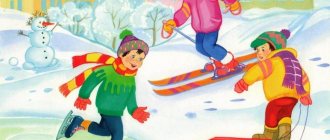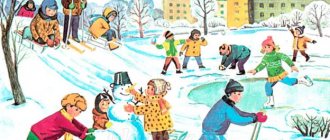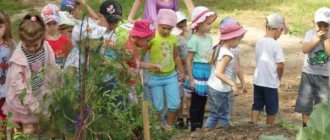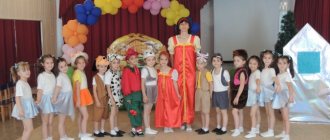Walks in January in the preparatory group. Card file with goals according to the Federal State Educational Standard
Winter walks in January. Preparatory group of preschool educational institution
Walk #1.
Observation of wintering birds Purpose: to consolidate knowledge about wintering birds; to form an idea of how wintering birds obtain food; cultivate a desire to care for and protect them. Progress of observation The blizzard has broken out again, Tearing off the snow caps. The bird is completely frozen and sits with its paws tucked in. The teacher asks the children questions:
- What birds are called wintering birds?
-What do they eat? — What wintering birds do you know? — Why don’t wintering birds fly to warmer climes for the winter? — How can a person help wintering birds? Wintering birds do not fly away from us to warmer climes, since they find food even in winter. They feed on buds, seeds and fruits of plants, hidden insects, and look for food near human habitation. Some birds die from the cold in winter. People can help wintering birds - tits are given unsalted lard, sparrows love millet and seeds. Watching the snow. Discuss with the children what happens when the snow creaks underfoot (the rays of snowflakes break with a crunch)
.
In different weather conditions, examine snowflakes through a magnifying glass. Didactic game “Who is bigger?”: What kind of snowflakes? (openwork, silver, delicate, cold, fluffy, lace, light, white...) Poem by S. Baruzdin “Snowflakes” Winter is loaded with snow From morning until dark. Snowflakes curl and swirl around our window. It was as if the stars were scattering around like sparks. They rush, silvery, and look into the house. They will ask you to come into the room, Then they will run away again, They will rush behind the glass, They will call you to go outside. Outdoor games: “Who is faster along the track?” Goal: learn to perform series jumps and sideways jumps. "Jumpers." Goal: to teach jumping on two legs with a forward movement of 2-3 m. Individual work on physical training. Improving running technique (naturalness, lightness, energetic push-off)
.
Goal: to develop coordination of movements. Labor activity Collecting snow to build a winter town. Goal: improve work skills, the ability to work together. Independent activity of children of the SRI “Builders” Goal: to form specific ideas about construction and its stages;
consolidate knowledge about working professions; cultivate respect for the work of builders; develop the ability to creatively develop the plot of the game. Games with MAF Remote materials: magnifying glass, shovels, ice cubes. Walk No. 2.
Observing birch trees in winter Purpose: to develop knowledge about the characteristics of tree life in winter; cultivate a caring attitude towards plants (do not touch branches and buds that are fragile from frost, as they break)
.
Progress of observation There is a birch tree in a cape, The fringe on the branches is ringing. The lighter, the softer the snowflakes, the colder the winter! In winter, the birch tree does not freeze, it is alive, but from frost its twigs and buds become fragile and quickly break, so they should not be touched. If we pick up branches broken off by the wind and put them in water, they will turn green. The teacher asks the children questions:
- How do trees feel in winter?
- What's happening to them? — What condition are the trees in in winter? (At rest.)
- How did you recognize the birch tree?
Observing tracks in the snow:
animals, people, birds, skis, sleds, cars
(learn to determine whether a track is fresh or left a long time ago)
.
Compare bird tracks on loose snow and trampled snow. Poem by N. Golinovskaya “Writing in the Snow” The snow is embroidered with a beautiful line, Like a white shirt. I call my dad into the yard: “Look at the pattern!” Dad looks down: “Here is a letter for you, Denis!” Birds and animals write: “Make us some feeders, Denis!” Outdoor games “Who needs the flag?” Purpose: to practice jumping with forward movement, to develop agility and determination. “Frost - Red Nose” Purpose: to teach children to run across the scattered ground from one side of the site to the other, dodging the trap, act on a signal, and maintain a motionless posture. Develop endurance and attention. Individual work on PHYS “Frisky bag”. Goal: practice jumping on two legs. Labor activity Covering tree trunks on the site with snow so that they do not freeze. Goal: learn to work together; cultivate hard work. Independent activity of children SRI “Ambulance” Goal: to arouse children’s interest in the professions of a doctor and nurse;
cultivate a sensitive, attentive attitude towards the patient, kindness, responsiveness, and a culture of communication. Games with MAF Remote materials: flags, shovels, ice cubes, ambulance suitcase. Walk #3.
Observing a crow Goal: expand the understanding of wintering birds, teach to distinguish them by appearance; cultivate love and respect for wintering birds. Progress of observation The teacher asks the children a riddle and asks them to answer questions. The cap is gray, the vest is non-woven, the caftan is speckled, and he walks barefoot. (Crow.)
- Who is this, what is the name of this bird?
—What are the features of her appearance? - Where she lives? -What does it eat? - Does she have enemies? Signs: a crow hides its nose under its wing - it means frost. Monitoring the weather conditions.
Develop the ability to independently recognize and name snowfall, drifting snow, frost, blizzard, and frost.
Teach children to compare these phenomena, find similarities and differences. Didactic game “Who is bigger?” Purpose: to practice selecting definitions for nouns and verbs corresponding to winter phenomena. What winter day? (frosty, cold, clear, snowy, short, windy, fabulous)
.
Outdoor games “Counter dashes” Purpose: to increase the motor activity of children while walking; “Winter and Summer” Purpose: to teach children to line up in 2 lines with their backs to each other, run fast, and catch their mate. Develop attention and reaction speed. Individual work on PHYS “Running in pairs” Goal: to develop motor activity. Labor activity Clearing the area and paths from snow. Goal: to cultivate diligence and the desire to complete the work started. Independent activity of children of SRI “Zoo” Goal: to expand children’s knowledge about wild animals: to cultivate kindness, responsiveness, sensitive, attentive attitude towards animals, a culture of behavior in public places.
Games with MAF Remote materials: shovels, ice cubes, animal figurines Walk No. 4.
Observing the sun Purpose: to continue to introduce natural phenomena, to give the concept of one of the signs of winter - frost; develop interest in inanimate objects of nature. Progress of observation Where are you, sun, really? We're completely numb. Without you, the water froze, Without you, the earth froze. Come out, sunshine, quickly! Caress and warm! Who noticed which direction the sun is in the morning? That's right, at sunrise, the sun rises there, and in the evening it will be in the other direction - in the west, where the sun will hide at night. In winter, the sun shines, but does not warm, it rises late and goes to bed early. The days in winter are short, the nights are long. In summer the sun warms, in winter it freezes. In winter, the sun smiles through tears. Observation of trees Based on the characteristics of the trunk, the location of the branches, the characteristics of the buds, children distinguish between trees: birch (white trunk and thin hanging branches extending from large branches)
, larch
(dark trunk with thick bark and drooping branches)
, poplar
(gray trunk with raised up branches)
.
Riddle: We saw him dressed in spring and summer, And in the fall, all the shirts were torn off the poor thing, But the winter snowstorms dressed him in furs. (Tree in winter) Outdoor games: “Empty Space” Purpose: teaches you to run without bumping into each other. “Make a figure” Purpose: to teach how to perform actions on a signal, Individual work on PHYSICAL Elements of Hockey. Goal: learn to roll the puck in a given direction, roll it into the goal. Labor activity: Shoveling snow into a certain place to build ice figures. Goal: learn to work together, achieve goals through common efforts. Independent activity of children: SRI “Builders” Purpose: to consolidate knowledge about working professions;
cultivate respect for the work of builders; develop the ability to creatively develop the plot of the game. Games with MAF Remote materials: shovels, sticks, puck. Walk No. 5.
Observing the weather Purpose: to clarify and concretize the idea of winter; teach to establish the dependence of the life of plants and animals on changes in inanimate nature. Progress of the walk Draw the children's attention to the weather. Ask to characterize it (temperature, cloudiness, precipitation, wind force)
, using as many epithets as possible.
Compare the weather with yesterday, what has changed, and what signs children use to draw conclusions. Admire the beauty of the winter landscape. Signs: • If there are many frequent and long icicles hanging in January, the harvest will be good; • if in January there are frequent snowfalls and blizzards, then in July there are frequent rains. Didactic game “What would happen if...” Purpose: to teach to establish cause-and-effect relationships. The teacher begins the sentence, and the children finish: For example, “what would happen if...” in winter, streams ran, in summer, leaves began to fall, in winter it started to rain, in the fall the rivers were covered with ice, in the spring the buds on the trees did not begin to bloom, etc. Observing frost Draw children's attention to trees covered with frost. Frost is formed from small ice plates that are arranged in rows along the branches. In the sun, frost glitters and sparkles, at sunset it turns pink, early in the morning and in the evening it turns blue. Explain that, unlike snow and ice, frost is not harmful to trees. Outdoor games: “Homeless Hare.” Goal: to exercise the ability to run without bumping into each other; to develop agility and endurance. “Traps” Purpose: to teach how to run around the site in all directions while dodging. Develop the ability to act on a signal, dexterity, and speed of movement. Individual work on PHYS “Knock down the flag.” Goal: learn to throw snowballs at a target; develop accuracy and attention. Labor activity Feeding birds in the kindergarten area. Goal: to cultivate love, careful and caring attitude towards wintering birds. Independent activity of children: SRI “Veterinary Hospital” Purpose: to arouse children’s interest in the profession of a veterinarian;
to cultivate a sensitive, attentive attitude towards animals, kindness, responsiveness, and a culture of communication. Games with MAF Remote materials: feeders, shovels, ice cubes Walk No. 6.
Observation of snow and ice Purpose: to develop a realistic understanding of inanimate nature; consolidate knowledge that water can be in a solid state (snow, ice)
.
Progress of observation Oh, winter beauty! She whitewashed all the forests, swept up mountains of snow, and invited us to ride. The teacher conducts an experiment and asks the children questions. Place ice in one glass and snow in the other. — What color does ice feel like? Name its properties. — What color does snow feel like? Name its properties. —What are snow and ice made of? Now we put both glasses in a warm place, after a while we’ll see what happens to the ice and snow. Monitoring the weather conditions. Develop the ability to independently recognize and name snowfall, drifting snow, frost, blizzard, and frost. Teach children to compare these phenomena, find similarities and differences. Didactic game “Who is bigger?” Practice selecting definitions for nouns and verbs that correspond to winter phenomena. What winter day? (frosty, cold, clear, snowy, short, windy, fabulous)
.
Frost (what does it do?)
freezes, crackles, grows stronger, freezes, stands, strikes, weakens, fetters, does not order to stand.
The wind (what is it doing?)
blows, sweeps, carries
(snow)
, howls, howls, circles.
Outdoor games: “Entertainers” Purpose: to teach children to walk in a circle, holding hands to the right, to the left. Repeat the movements after the driver. Develop attention, memory, creativity. “Counter dashes” Purpose: to teach children to run from one side of the playground to the other at a fast pace. Develop attention and speed of movement. Individual work on PHYSIO Development of movements. Goal: learn to throw snowballs into the distance. Work activity : Cleaning the area from snow. Goal: to reinforce ideas about the protective properties of snow. Independent activity of children: SRI at the request of children Goal: to evoke a desire to organize their favorite games, to develop the ability to creatively develop the plot of the game.
Games with MAF Remote materials: glasses for experiments, shovels, ice cubes. Walk No. 7.
Observing the work of a janitor Goal: to continue to instill in children a love of work and respect for the work of adults. Draw the children's attention to how diligently the janitor removes the snow and sprinkles the paths with sand so that the children can walk comfortably. Riddle: It's snowing quietly. White snow, shaggy. We will clear the snow and ice in the yard... (with a shovel)
.
Remind people why they need to collect snow in holes in trees and shrubs. Signs: • in January there are many frequent and long icicles hanging - the harvest will be good; • frosty January – a fruitful year. Didactic game “Who knows, let him continue to count” Goal: development of auditory attention, consolidation of the skill of ordinal counting within 10, development of thinking. Outdoor games: “One, two, three - I’m watching!” Goal: develop reaction speed, teach to follow the rules of the game. All players stand behind the starting line, the driver far ahead stands behind them. At the signal, the game begins. All players try to run to the driver and insult him. But he can suddenly say: “One, two, three - I’m looking!” - and turn around sharply. If he turns around and sees someone moving, he sends them back to the starting line. The one who first insults the driver takes his place and leads the game. “We are funny guys” Purpose: to teach to listen carefully to the teacher’s command; develop attention, monitor the correct completion of tasks. Individual work on PHYS “Don’t knock down the flag.” Goal: learn to walk like a snake between objects without knocking them over. Labor activity Making a slide for dolls. Goal: to teach to work together, to receive joy from the work performed and its result. Independent activity of children: SRI “Drivers” Goal: to consolidate children’s ideas about the work of transport workers, about their social significance.
Games with MAF External materials: steering wheel, dolls, sleds, shovels Walk No. 8.
Observing the beauty of the winter landscape Purpose: to cultivate in children a cognitive interest in nature; to develop sensitivity to the perception of the winter landscape. Read the poems: January Stings your ears, stings your nose, frost creeps into your felt boots. If you splash water, it’s not water that will fall, but ice. Even the bird cannot fly; the frost freezes the bird. The sun turned towards summer. What month is this, tell me? *** In January, in January there is a lot of snow in the yard. Snow on the roof, on the porch. The sun is in the blue sky. The stoves are lit in our house, and the smoke rises into the sky in a column. S. Marshak Make riddles: We saw him dressed in spring and summer. And in the fall, all the poor girl’s shirts were torn off. But the winter snowstorms dressed him in furs. (Tree in winter.)
In the spring it dies, in the fall it comes back to life.
(Snow.) Didactic game “Is this true or not?” Goal: find inaccuracies in the text. Listen carefully to the poem. Who will notice more fables, what actually does not happen. It's a warm winter now, the grapes are ripe here. A horned horse jumps in the snow in a summer meadow. In late autumn, the bear likes to sit in the river. And in winter, among the branches, “Ga-ga-ga” the nightingale sang. Quickly give me the answer: is it true or not? Children find inaccuracies and replace words and sentences to get it right. Outdoor game “Mousetrap” Purpose: to teach children to run under clasped hands in and out of the circle, without bumping into each other, to act on a signal. Develop agility, speed, spatial orientation. “Winter and Summer” Purpose: to teach children to line up in 2 lines with their backs to each other, run fast, and catch their mate. Develop attention and reaction speed. Individual work on PHYSICAL Elements of Hockey. Goal: learn to roll the puck in a given direction, roll it into the goal. Labor activity: Snow removal on site. Purpose: to teach how to complete a task collectively. Independent activity of children: SRI at the request of children Goal: to evoke a desire to organize their favorite games, to develop the ability to creatively develop the plot of the game.
Games with MAF Remote materials: clubs, balls, shovels, ice cubes Walk No. 9.
Observation of snowfall Purpose: to generalize knowledge about winter phenomena in nature through observations; continue to develop children's search activities. Read N. Sadovsky's poem Snowfall Snowfall, snowfall, like elephants, snowdrifts! Snow and snow for three days in a row of the highest standard. It falls, falls, and makes everyone happy at first - And what did this snowfall do? And winter laughs: - That’s what it’s called - snowfall, so that everyone falls into snowdrifts, into snowdrifts, into soft snowdrifts in a row! Watch the snowfall with your children. If there is a strong wind during a walk, then the snowflakes cannot be seen - solid snow dust flies. It was the wind that broke off their beautiful rays from the snowflakes. We need to explain to children that in cold weather the snow crunches underfoot because the rays of the snowflakes break. On a windless frosty day, snowflakes fall slowly, they are large, shiny, like flowers or stars. They fall one at a time, so they can be clearly seen on a sheet of dark paper. Didactic game “Where have I been?” Purpose: - to form accusative plural forms of animate or inanimate nouns. Outdoor games: “Frost - red nose” Purpose: to teach children to run across the scattered ground from one side of the site to the other, dodging the trap, act on a signal, and maintain a motionless posture. “Sly Fox” Purpose: to teach children to run without bumping into each other, to act on a signal, and to navigate the playground. Individual work on PHYSICAL EXERCISE Exercise in standing long jumps. Goal: develop agility and endurance. Labor activity Construction of a slide on the site. Goal: to cultivate diligence and the desire to work together. Independent activities of children: SRI "Ministry of Emergency Situations" - rescuers Goal: to consolidate the knowledge of children with the difficult and honorable profession of a rescuer, to teach, if necessary, to act clearly and harmoniously.
Games with MAF Remote materials: shovels, ice cubes Walk No. 10.
Observation of a blizzard Purpose: to give an idea of the movement of snow in windy weather Progress of observation Make a riddle and ask to answer questions. I walk in the field, I fly in freedom, I spin, I mutter, I don’t want to know anyone. I run along the snow, sweeping up snowdrifts. (Blizzard.)
1) What do you think a blizzard is?
(Moving snow under the influence of strong winds from one place to another.)
2) Look carefully, what happens to the snow?
(Snow moves in the direction of the wind.)
3) Why do snowdrifts appear during a snowstorm?
(Snow moves from one place to another and lingers where there is an obstacle, so snowdrifts form.)
4) Do you think a blizzard is more harmful or beneficial?
(The roots of the trees are exposed - they can freeze, snow is blown away from the fields and beds, impassable snowdrifts appear, you can’t go for a walk.)
Who is this, howling, flying without wings and covering its tracks without a broom?
Makes snowdrifts from snow dough, moving them from place to place. (Blizzard.) Didactic game “Listen carefully” Goal: development of voluntary attention. Children moving in a circle take poses depending on the leader’s command: one clap - take the “stork” pose (stand on one leg, arms to the sides)
;
two claps - “frog” pose (sit down, heels together, toes to the sides, hands between your legs on the floor)
;
three claps - resume walking. Outdoor games: “Empty Space” Purpose: to teach children to quickly race in opposite directions. Develop reaction speed and attention. “Pair running” Purpose: to teach children to run in pairs, without releasing their arms, to go around objects. Develop dexterity and attention. Individual work in physical exercises Development of movements Goal: improve the technique of running long jumps Labor activity Cleaning the feeder from snow and bird food residues, feeding the birds. Goal: to cultivate a humane attitude towards “our smaller brothers.” Independent activity of children: SRI “Snow Cafe” Goal: to develop imagination, interest and respect for the profession of a cook.
Games with MAF Remote materials: sand sets, shovels, ice cubes. Walk No. 11.
Weather observation Purpose: to form elementary ideas about changes in the position of the Earth relative to the Sun. Progress of the walk Introduce the properties of snow. Find out what can be done on the site, what to take with you for a walk, what to wear. When going for a walk, pay attention to the weather, note how it has changed compared to yesterday. Note that the sun is rising earlier, the day is getting longer, which means the frost will soon pass. Didactic exercise “Winter Fun” Invite children to perform the movements described in the poem: We play snowballs in winter, We walk through snowdrifts, And we run on skis, We fly on ice skates, And we sculpt a snow maiden, Guest - we love winter! Didactic game “Speak, don’t delay” Goal: to develop speech activity and vocabulary. Progress of the game. Children stand in a circle. One of them is the first to say the word syllable by syllable; the person standing next to him must name the word starting with the last syllable of the word just spoken. (Wa-za, za-rya, rya-bi-na) Outdoor games: “Hunters and Animals” Purpose: to teach children to throw a small ball, trying to hit the animals, to perform imitative movements, depicting forest animals. Develop dexterity and eye. “Owl” Purpose: to teach children to act on a signal, run, scatteredly imitating birds, and maintain a motionless posture. Develop balance. Individual work on PHYSIO Development of movements. Goal: - strengthen the ability to throw a “snowball” at a target. Labor activity: Cleaning the feeder from snow and bird food residues, feeding the birds. Goal: to cultivate a humane attitude towards “our smaller brothers.” Independent activity of children: SRI “Snow Cafe” Goal: to develop imagination, interest and respect for the profession of a cook.
Games with MAF Remote materials: sand sets, shovels, ice cubes. Walk No. 12.
Observation of trees and shrubs Purpose: to expand and deepen knowledge about plants in winter. Read M. Stepanov’s poem “Winter Forest” What a miracle the winter forest is, How many fabulous wonders! In this fairy tale I am in the forest, Is it a dream or a reality in front of me? Here is a luxurious row of birch trees, White shawls glow with Silver - but to the side there are girls wearing Christmas trees in fur coats. Oh, what silence, White-white country! Ask the children questions:
1) How are trees different from shrubs?
2) What are the names of trees that shed their leaves in the fall? 3) What benefits do trees and shrubs bring? Research activity: Excavate deep snow where grass grew. Under the snow cover you can see small green plants with weak leaves pressed to the ground. Lead the children to the conclusion that snow protects the soil, preventing it from cooling. Didactic game “Describe your neighbor” Purpose: To teach to carefully examine a person and give a verbal portrait. Outdoor games: “Frost - red nose” Purpose: to teach children to run across the scattered ground from one side of the site to the other, dodging the trap, act on a signal, and maintain a motionless posture. “Pair running” Purpose: to teach children to run in pairs, without releasing their arms, to go around objects. Develop dexterity and attention. Individual work on PHYSICAL Elements of Hockey. Goal: learn to roll the puck in a given direction, roll it into the goal. Independent activities of children: SRI "Ministry of Emergency Situations" - rescuers Goal: to consolidate the knowledge of children with the difficult and honorable profession of a rescuer, to teach, if necessary, to act clearly and harmoniously. Games with MAF Remote materials: sticks and balls, shovels, ice cubes
We recommend watching:
Consultation for parents in kindergarten. Walks in winter Walks in the middle group. December. Card index with goals according to the Federal State Educational Standard. Winter Walks in January in the middle group. Card file with goals for the Federal State Educational Standard Walking in the middle group. February. Card index with goals according to the Federal State Educational Standard. Winter
Similar articles:
Winter experiences and experiments for children
Organization of work activities during a walk in kindergarten.
Organization of work activities during a walk in kindergarten.
Labor education is one of the most important aspects of raising the younger generation.
It is necessary to pay attention to the work activity of children during a walk.
Varied work in nature brings children a lot of joy and contributes to their all-round development. In the process of labor education, the following tasks are solved:
- A love for nature and a caring attitude towards it is instilled;
- An interest in work activity and a conscious, responsible attitude towards it are instilled;
- Social relationships with peers and adults are strengthened;
- Children's horizons expand (properties and qualities of objects, relationships in nature, knowledge about plants and animals);
- Development of intellectual skills (selection of tools, outlining a sequence of actions, distributing them over time, evaluating the results of work);
- Development of sensory perception;
- Observation;
- Respect for working people;
- Satisfying aesthetic needs.
The content and forms of organization of work activity depend on the weather and time of year. So, in the fall, children collect flower seeds and harvests from the garden; in winter, they can rake snow and make various structures out of it. It is necessary to strive to make child labor joyful, helping children to master useful skills and abilities. Labor tasks should be within the capabilities of children and, at the same time, require certain efforts from them. The teacher makes sure that they do their work well and finish what they started. To successfully solve problems of self-development and accuracy, instilling hard work, it is very important to choose the right children's equipment - rakes, shovels, scoops, buckets.
Of great importance when organizing work with children during a walk is the emotional attitude to the task, which is set by the teacher even before the start of work. The work itself will not always interest children; sometimes they are attracted by the goal set by the teacher, and while doing the work they are captured by the community of interests, coherence, and competitiveness. It is equally important to create the right motivation, to explain why it is necessary to do this work today and in this particular way. Children in the older group should be led to understand that they need to do not only interesting work, but also necessary work. To diversify and brighten up monotonous activities, the teacher can invite children to solve riddles. In order to properly guide the observations and work activities of children during a walk, the teacher must expand his knowledge of the biology of plants and animals, possess practical skills in this area, as well as methods for conducting observations, excursions, and organizing the work of children of senior preschool age.
The work of preschoolers during a walk creates a favorable environment for their physical development, improves movements, strengthens the nervous system, and gives them pleasure and joy. It is important that for each child the tasks are feasible, interesting and varied.
The forms of organizing children's labor are:
Individual work assignments;
Work in groups;
Teamwork.
Individual work assignments are used in all age groups of kindergarten. Children are involved in collecting seeds: from the flower bed, autumn leaves for the herbarium and decorating the group room, maintaining order in the walking area and verandas.
Collective work makes it possible to develop work skills and abilities simultaneously in all children in the group. During collective work, the ability to accept a common goal of work, coordinate one’s actions, and plan work together is formed.
When planning work assignments, the teacher must remember to choose the optimal load for each child, depending on his capabilities. Types of work must be alternated taking into account its nature.
The content of child labor must be meaningful for preschool children. Then the attitude towards him will be more responsible.




